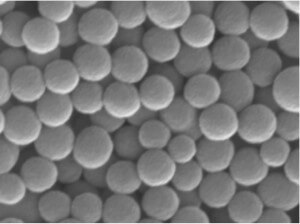Is There Really Now An “Ultimate” Sunscreen?
Hot on the heels of a recent announcement about how DNA may be the secret to a more effective, longer-lasting sunscreen comes word out of the University of California San Diego about yet another innovation that may produce an “ultimate” natural defense against UV.
How does this one work? According to a paper published in the American Chemical Society journal ACS Central Science, the UC San Diego scientists say they’ve developed nanoparticles that mimic the behavior of natural melanosomes, natural structures within cells that produce melanin, and thereby protect our skin, eyes and other tissues from the sun’s UV radiation.

Scanning electron microscope image of the synthetic melanin-like nanoparticles, which protected skin cells from DNA damage. Image by Yuran Huang and Ying Jones, UC San Diego
Animals, from fish and crustaceans on up, produce melanin particles naturally, and it’s seen in everything from iridescent bird feathers to for iridescent feathers in birds or the pigmented eyes and skin of some reptiles. Extracting melanins from natural sources has been a difficult and complex process, so scientists have turned to synthetic alternatives:
“Basically, we succeeded in making a synthetic version of the nanoparticles that our skin uses to produce and store melanin and demonstrated in experiments in skin cells that they mimic the behavior of natural melanosomes,” said Nathan Gianneschi, a professor of chemistry and biochemistry, materials science and engineering and nanoengineering at UC San Diego, who headed the team of researchers.
The researchers involved aren’t talking about the immediate application of their breakthrough as a consumer product, but more as a treatment for conditions such as vitiligo and albinism, where the skin’s natural ability to produce melanin is compromised.
New protection plateaus
So is this really, despite the pomp surrounding it, really an “ultimate” sun protection product? Maybe yes, maybe no: that depends on whether or not it stands up to real-world implementation.
But when you consider how quickly new developments in sunscreen ingredient technology and formulation are coming at us, it’s exciting to realize how much work is being done in so many laboratories and research departments to advance the game.
That intensity of innovation is probably the best proof there is that no such thing as an “ultimate” sunscreen product is anywhere close. There’ll always be someone out to make even the best products better.
Considering the huge upside in the sunscreen category, it’s not surprising how fast the pace of experimentation and development has become. Or how quickly the team at UC San Diego jumped into applying for a patent for polydopamine-based artificial melanins as an intracellular UV-shield. The prospects ahead are almost too bright to believe.
